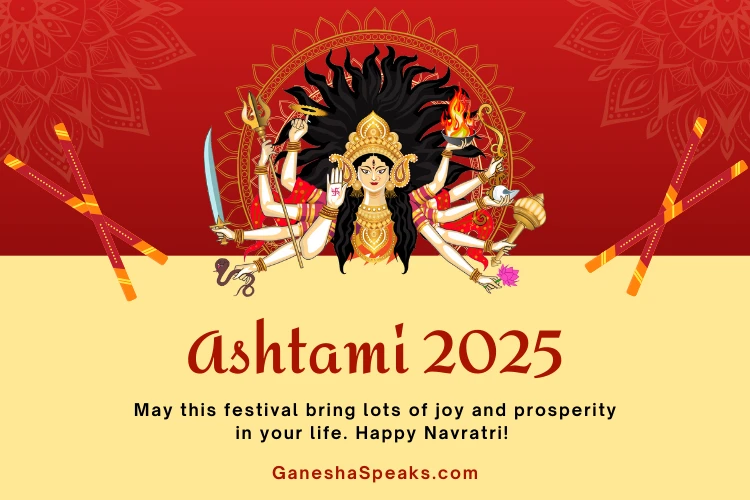Ganesha says Durga Ashtami 2025 will be observed on Tuesday, 30th September 2025. Known as Maha Ashtami, this day marks one of the most important celebrations during the nine days of Navratri. It is dedicated to Goddess Durga in her fierce Mahishasura Mardini form, symbolising the victory of divine feminine power over demonic forces. On this day, devotees keep fasts, perform special pujas, and conduct Kanya Puja with deep devotion.
Date and Muhurat for Durga Ashtami 2025
- Ashtami Tithi Begins: 4:31 PM on 29th September 2025
- Ashtami Tithi Ends: 6:06 PM on 30th September 2025
(Timings may slightly differ depending on your city and Panchang calculations)
Ganesha advises that devotees should rise early, take a holy bath, and perform the puja during the auspicious hours to gain maximum spiritual benefits.
Importance of Durga Ashtami
According to mythology, on this day Maa Durga killed the demon Mahishasura, restoring balance between good and evil. Hence, Durga Ashtami is celebrated as the triumph of Dharma over Adharma.
Ganesha feels that this day is especially sacred for worshipping Maa Mahagauri, the eighth form of Goddess Durga. She is associated with purity, forgiveness, and divine blessings. Devotees who worship Maa Mahagauri are blessed with:
- Liberation from past sins
- Akhand Suhaag (marital bliss) and protection of married life
- Prosperity, fortune and inner strength
- Supernatural achievements (alaukik siddhis) through deep devotion
Ganesha predicts that those who sincerely observe this day with fasting, prayer, and Kanya Puja are showered with blessings not only from Maa Mahagauri but also from all nine forms of Goddess Durga.
How Durga Ashtami is Celebrated
- Morning Rituals – Devotees take a holy bath, clean their homes and puja space, and worship Goddess Durga with flowers, incense, and diya.
- Kanya Puja (Kumari Puja) – Nine young girls, representing the nine forms of Durga, are worshipped. Their feet are washed, they are offered food, clothes, and gifts.
- Fasting and Chanting – Many devotees observe a complete fast, chanting mantras such as Om Dum Durgayai Namah and reciting Durga Saptashati or Devi Kavach.
- Offerings by Married Women – Married women offer saree, chunri, bangles, sindoor, and other suhag items at the feet of the Goddess, praying for the protection of their marital life.
- Sandhi Puja – One of the most sacred rituals of Durga Ashtami. The last 24 minutes of Ashtami and the first 24 minutes of Navami are called Sandhi Kaal. Ganesha says this is the holiest time for invoking the Goddess. During this puja, 108 lamps are lit, and symbolic offerings like banana, cucumber, and pumpkin are made as substitutes for sacrifice.
Astrological and Spiritual Significance
Ganesha explains that on Ashtami, devotees worship Maa Mahagauri. In astrology, the Moon holds a significant place after the Sun. For people whose Moon is placed in Scorpio, or who suffer from afflictions such as Moon-Rahu, Moon-Ketu, or Moon-Saturn conjunctions, worshipping Maa Mahagauri on this day is considered very important.
By performing her puja, the Moon becomes stronger, leading to:
- Mental peace and emotional stability
- Enhanced self-confidence
- Freedom from obstacles and anxieties
- Spiritual growth and clarity of mind
Regional Traditions Across India
- West Bengal: Durga Ashtami is the grandest day of Durga Puja. Maha Ashtami rituals, Sandhi Puja, and the beating of dhak drums fill the air. Women in red-and-white sarees worship the Goddess with devotion.
- Assam and Tripura: Sandhi Puja and cultural performances on the beats of traditional drums mark the day.
- Bihar and Jharkhand: Devotees maintain an Akhand Jyoti throughout Navratri.
- Uttar Pradesh and Delhi: Kanya Puja and havan rituals are performed, while Ramleela enactments take place in open grounds.
- Odisha: Durga Puja coincides with the beginning of Kali Puja, accompanied by music and traditional dance.
- Maharashtra and Gujarat: Special havans, Kanya Puja, and the famous Garba and Dandiya dances light up the night.
- South India (Karnataka, Tamil Nadu, Andhra Pradesh): Associated with Bommai Golu (doll displays) and Ayyappa worship.
- Himachal Pradesh: The famous Kullu Dussehra begins with Durga Ashtami celebrations, including local deity processions.
Know What the Stars Hold for You Upcoming Year. Get Your 2026 Yearly Horoscope Report Now!
Do’s and Don’ts on Durga Ashtami
Do’s:
- Keep fast and worship Maa Durga with devotion.
- Perform Kanya Puja and offer gifts to nine young girls.
- Recite Durga Saptashati, Devi Kavach or chant Om Dum Durgayai Namah.
- Clean and decorate the puja place with red and yellow flowers.
- Donate food, clothes, and grains to the needy.
- Spend time with family and express gratitude to the Goddess.
Don’ts:
- Avoid non-vegetarian food and alcohol.
- Do not indulge in anger, arguments, or negativity.
- Cutting hair or nails during Navratri is considered inauspicious.
- Do not neglect the puja or perform it without cleanliness.
- Do not waste food or prasad – it is seen as disrespect to the Goddess.
Modern Relevance of Durga Ashtami
In today’s world, Ganesha feels Durga Ashtami is not just a religious festival but also a cultural symbol of unity and strength.
- Collective pujas and community gatherings strengthen social bonds.
- Digital puja platforms and online aartis allow devotees to participate from afar.
- Eco-friendly pandals and charity events make the celebrations socially responsible.
- The festival highlights women empowerment and feminine energy, reminding society of the importance of Shakti.
- For the youth, it is a reminder of courage, self-discipline, and the power of inner strength.
Ganesha says Durga Ashtami 2025 is a day to invoke divine energy, celebrate the triumph of righteousness, and seek the blessings of Maa Durga for health, prosperity, and strength. By observing this day with devotion, every devotee can overcome challenges, find peace, and walk on the path of Dharma with confidence and courage.
Read Ashtami 2025: Know The Puja Vidhi, Samagri List, and Mantras
